There’s something so comforting about a golden, fragrant stuffing that’s rich with herbs and butter, right? This Buttery Herb Stuffing Recipe has been my go-to for holidays and cozy dinners because it hits all those warm, savory notes that invite second helpings. Plus, it’s one of those recipes that fills your kitchen with such an amazing aroma, you'll instantly feel like home.
Jump to:
Why You'll Love This Recipe
What makes this stuffing recipe a staple in my kitchen is how it balances buttery richness with fresh herbs in a way that’s hearty but never heavy. It’s also incredibly forgiving and easy enough to become your new family favorite.
- Flexible Bread Options: Use stale, toasted, or even a mix of different breads for amazing texture and flavor depth.
- Fresh Herbs Galore: Sage, rosemary, and parsley lift the stuffing beyond the ordinary, creating that irresistible fresh-herby kick.
- Simple Buttery Base: Butter melts into the veggies creating that classic, luscious stuffing flavor everyone loves.
- Make-Ahead Friendly: You can prep this ahead, refrigerate, and reheat without losing much of that fresh-from-the-oven magic.
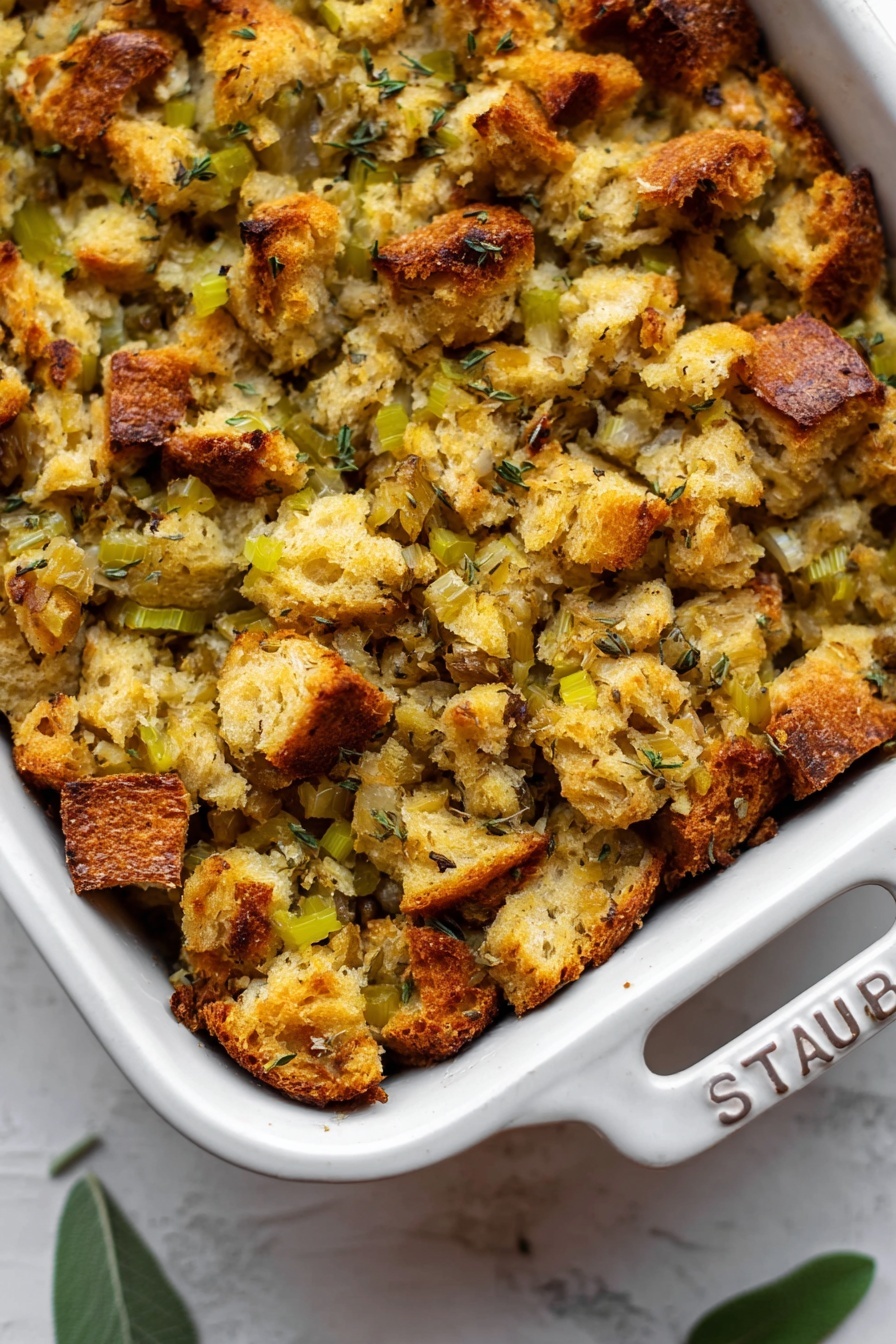
Ingredients & Why They Work
For me, every ingredient in this Buttery Herb Stuffing Recipe has a purpose. The buttery base warms up the fresh herbs, while the onion, celery, and garlic build those layers of savory goodness. Picking the right bread and stock completes the ensemble for best results.
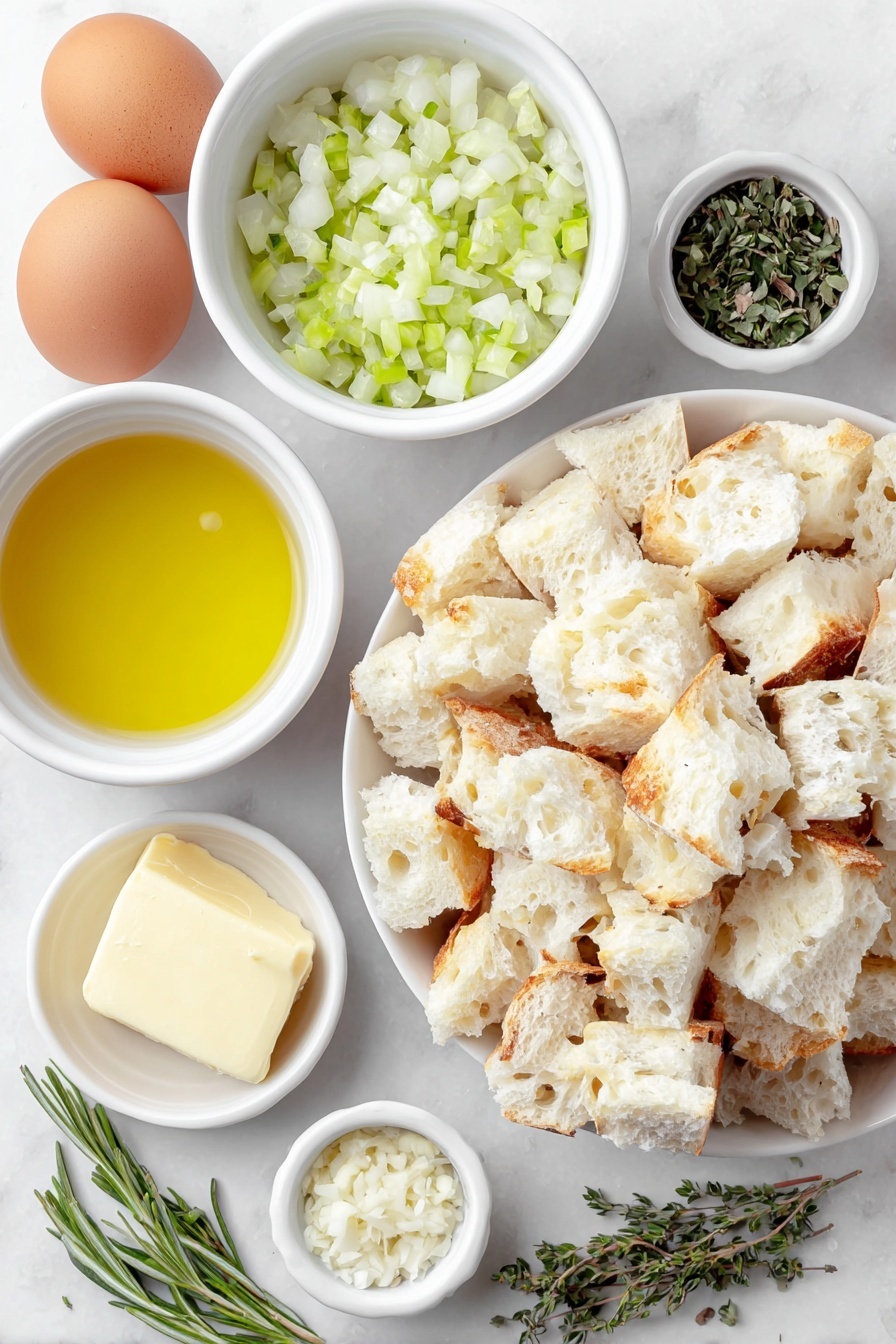
- Bread Cubes: Whether you use stale or toasted bread, the bread soaks up the flavorful liquids without getting soggy, giving you a fluffy yet structured stuffing.
- Unsalted Butter: Using unsalted butter lets you control seasoning and gives the stuffing that rich, comforting mouthfeel.
- Sweet Onion: Adds subtle sweetness balancing the savory herbs, sautéed to tender perfection.
- Celery: Brings in crunch and freshness, plus great texture contrast.
- Garlic: Intensifies the aroma and flavor without overpowering the herbs.
- Fresh Sage, Parsley, Rosemary: These herbs are the heart of the recipe, lending bright, piney, and earthy notes that make this stuffing unique.
- Chicken or Vegetable Stock: The stock moistens the bread cubes while adding savory depth—choose veggie stock for vegetarian-friendly versions.
- Eggs: Bind everything together so the stuffing holds its shape when baked.
Make It Your Way
I love playing around with this stuffing depending on the time of year or who I’m feeding. It’s a super adaptable recipe that really welcomes your own spins.
- Herb Variations: Sometimes I mix thyme or tarragon in with the sage and rosemary to give it a subtle twist. It’s a great way to use what you have on hand.
- Bread Mix: Using a combo of sourdough and Italian breads gives the stuffing a delightful mix of textures and flavors—crispy edges and tender interior.
- Vegetarian Version: Swap in vegetable stock and add toasted nuts or dried cranberries for a festive touch.
- Stuff the Bird: I’ve stuffed turkey with this mixture—the buttery herbs penetrate the whole bird, making it extra flavorful.
Step-by-Step: How I Make Buttery Herb Stuffing Recipe
Step 1: Prepare Your Bread Cubes for Perfect Texture
Start by choosing your bread. I prefer a mix of stale and toasted cubes for that perfect balance of soft inside and slightly crisp edges. If you’re starting with fresh bread, slice it into cubes and toast them at 350°F for about 15 minutes until lightly browned—don’t let them get too dark or dry! You can also set the cubes out in a baking dish loosely covered overnight to dry out naturally. The key is to avoid overly fresh bread so the stuffing isn’t mushy.
Step 2: Sauté the Aromatics in Butter
In a large skillet or Dutch oven, melt 1 cup of unsalted butter over medium heat. Add diced sweet onions, celery, and minced garlic with a generous pinch of kosher salt and pepper. Cook for about 8-10 minutes until everything softens and smells incredible. As the veggies cook, stir in fresh sage, parsley, and rosemary and let those herbs bloom for a minute more. Adding 1 cup of chicken or veggie stock here helps them meld beautifully.
Step 3: Combine and Bind
Pour the aromatic veggie mixture over your bread cubes in a large bowl or your baking dish. Toss everything well so each cube is coated with buttery herby goodness. In a separate bowl, whisk together the eggs and remaining 1 ½ cups of stock, then gently fold this in. The eggs will bind the stuffing together during baking, so don’t skip this step!
Step 4: Bake to Golden Perfection
Butter or spray a 9x13-inch baking dish and spread the stuffing evenly. Bake at 350°F for 45-50 minutes until the top is golden brown and the internal temperature hits 160°F. If you notice the top browning too fast, tent with foil to keep it moist. This step is where the magic happens—a crusty topping with tender, fragrant center.
Top Tip
Through lots of holiday cooking, I’ve learned a few tricks that make this Buttery Herb Stuffing truly shine every time.
- Use Mixed Breads: Combining two types like sourdough and Italian offers excellent texture contrast—crispy, chewy, and soft all at once.
- Don’t Skip the Butter: Butter is flavor gold here. Using unsalted lets you control seasoning and ensures that rich, silky mouthfeel.
- Sauté Gently: Have patience cooking onions and celery — softening them slowly releases natural sweetness which balances the herbs perfectly.
- Let It Rest Before Baking: After combining, let the mixture sit for 10-15 minutes so the bread absorbs all flavors. It really improves your results.
How to Serve Buttery Herb Stuffing Recipe

Garnishes
I like adding a sprinkle of fresh chopped parsley or a few whole fresh sage leaves on top right before serving—it adds a pop of color and fresh aroma. Sometimes I toss in toasted pecans or dried cranberries on the side for a hint of crunch and sweet contrast that goes beautifully with the buttery herbs.
Side Dishes
This stuffing pairs beautifully with roasted turkey or chicken, roasted Brussels sprouts, creamy mashed potatoes, and a tangy cranberry sauce. Whenever I make this, I keep those classic sides on hand because they complement the herbs and buttery textures so well.
Creative Ways to Present
For special occasions, I’ve served this stuffing inside hollowed-out small pumpkins or acorn squash—that always impresses guests and tastes amazing. You can also bake it in individual ramekins for personalized servings. It makes the dinner feel extra special without extra effort.
Make Ahead and Storage
Storing Leftovers
Once cooled, I store leftovers airtight in the fridge and it keeps well for up to 3 days. I find the flavors deepen overnight, so leftovers are almost as good as freshly baked.
Freezing
I’ve frozen this stuffing before by fully baking it, then cooling and wrapping tightly in foil. When ready to eat, just thaw in the fridge overnight and reheat in the oven. The texture holds up surprisingly well, making it a great make-ahead option for busy holidays.
Reheating
To reheat, I warm it uncovered at 350°F for about 20-25 minutes, sometimes tenting with foil if I see it browning too fast. Sprinkling a little broth on top helps keep it moist when reheating.
Frequently Asked Questions:
Absolutely! Swap the unsalted butter for a plant-based margarine or oil and use vegetable stock. You can omit the eggs or replace them with a flax egg (1 tablespoon flaxseed meal + 3 tablespoon water) to bind the stuffing.
Using slightly stale or toasted bread is ideal because it absorbs the flavorful liquids without becoming mushy. A mix of sourdough and Italian or French bread offers great texture and taste. Avoid very fresh bread unless you toast it first.
Yes! This Buttery Herb Stuffing Recipe works beautifully for stuffing poultry. Just make sure the bird and stuffing reach the proper internal temperature (165°F for the bird, 160°F for the stuffing) for food safety.
You can prepare this stuffing mixture a day ahead, store it covered in the refrigerator, and bake it right before serving. Just let it sit at room temperature for about an hour before baking to ensure even cooking.
Final Thoughts
I’ve made this Buttery Herb Stuffing Recipe for family gatherings, friendly potlucks, and quiet Sunday dinners, and it never disappoints. The buttery, herby aroma fills the kitchen with warmth, and the texture keeps everyone coming back for seconds. It’s one of those classic recipes that feels fancy yet approachable—a perfect companion for any meal. I really hope you give it a try and discover how simple it is to make an unforgettable stuffing that your family and guests will love as much as I do.
Print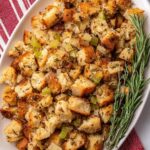
Buttery Herb Stuffing Recipe
- Prep Time: 45 minutes
- Cook Time: 50 minutes
- Total Time: 1 hour 35 minutes
- Yield: 8 servings
- Category: Side Dish
- Method: Baking
- Cuisine: American
- Diet: Vegetarian
Description
Our Favorite Buttery Herb Stuffing is a classic, flavorful side dish made with toasted bread cubes, sautéed onions, celery, garlic, fresh herbs, and a rich buttery base. Perfectly moist and aromatic, this stuffing is ideal for holiday meals or whenever you crave a comforting, savory dish.
Ingredients
Bread
- 18 to 24 ounces bread cubes (1.5 loaves or about 12 to 14 cups), preferably toasted or stale
Vegetables and Aromatics
- 3 cups diced sweet onion (about 2 large onions)
- 2 cups diced celery
- 6 garlic cloves, minced
Herbs and Seasonings
- Kosher salt and pepper (about 1 teaspoon each, plus to taste)
- 3 tablespoons chopped fresh sage
- 3 tablespoons chopped fresh parsley
- 3 tablespoons chopped fresh rosemary
Liquids and Eggs
- 1 cup unsalted butter
- 2 ½ cups chicken or vegetable stock
- 2 large eggs
For Baking
- Butter, olive oil, or nonstick spray for greasing the baking dish
- A mixture of fresh herbs for sprinkling (optional)
Instructions
- Prepare Bread Cubes: Choose stale or toasted bread for the best texture. Cut 1.5 pounds of bread into cubes and either let sit overnight loosely covered with foil, toast in the oven at 350 degrees F for about 15 minutes until crouton-like, or use store-bought toasted bread cubes. Mix different bread types like sourdough and Italian for varied texture.
- Preheat Oven and Prepare Dish: Preheat the oven to 350 degrees F. Grease a 9x13 inch baking dish with melted butter, olive oil, or nonstick spray. You may also use a larger baking dish or two 9x13 dishes if preferred.
- Sauté Vegetables and Herbs: Heat the butter in a large skillet or Dutch oven over medium heat. Add diced sweet onion, celery, minced garlic, and a big pinch of salt and pepper (about 1 teaspoon each). Cook until the onion and celery soften, about 8 to 10 minutes. Stir in the chopped sage, parsley, and rosemary; cook for another minute. Pour in 1 cup of the stock and mix well.
- Combine Mixture with Bread Cubes: Place bread cubes in a large mixing bowl or the baking dish. Pour the sautéed vegetable and herb mixture over the bread cubes and toss to coat evenly.
- Add Egg and Stock Mixture: In a small bowl or measuring cup, whisk together the remaining 1 ½ cups of stock and 2 large eggs. Pour this over the bread cubes and gently stir and fold until combined thoroughly.
- Bake the Stuffing: Transfer the mixture to the greased baking dish if using a bowl. Bake uncovered at 350 degrees F for 45 to 50 minutes, or until the internal temperature reaches 160 degrees F. If the top browns too quickly, tent with foil.
- Make-Ahead and Serving Tips: Stuffing can be made a day ahead and refrigerated. Remove from fridge 60 minutes before reheating. It can also be used to stuff a bird. For smaller servings (4 people), halve the recipe and bake in an 8x8 or 9x9 inch dish for the same amount of time. For larger servings (12 to 18 people), double the recipe and bake in a larger 10x15 inch dish or two 9x13 dishes, baking about 15 minutes longer.
Notes
- Using a mix of fresh and stale bread adds texture and flavor complexity.
- Vary bread types, such as sourdough and Italian, for a rustic stuffing texture.
- Toast the bread cubes in the oven for about 15 minutes at 350 degrees F if you don’t have stale bread available.
- Tent stuffing with foil during baking if it browns too quickly.
- Make the stuffing a day ahead to save time on the day of your meal; reheat thoroughly before serving.
- For added moisture and flavor, you can adjust the amount of stock slightly depending on bread dryness.
- Fresh herbs can be adjusted or substituted to taste.
Nutrition
- Serving Size: 1 cup
- Calories: 250 kcal
- Sugar: 2 g
- Sodium: 450 mg
- Fat: 15 g
- Saturated Fat: 9 g
- Unsaturated Fat: 5 g
- Trans Fat: 0 g
- Carbohydrates: 25 g
- Fiber: 2 g
- Protein: 5 g
- Cholesterol: 55 mg



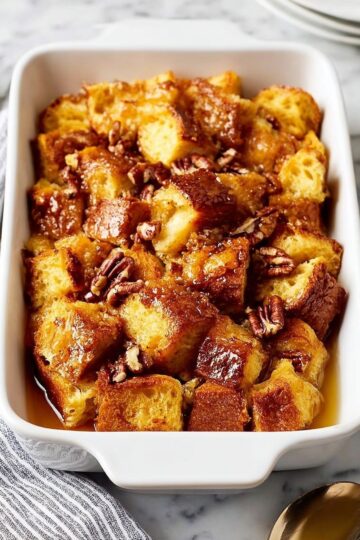
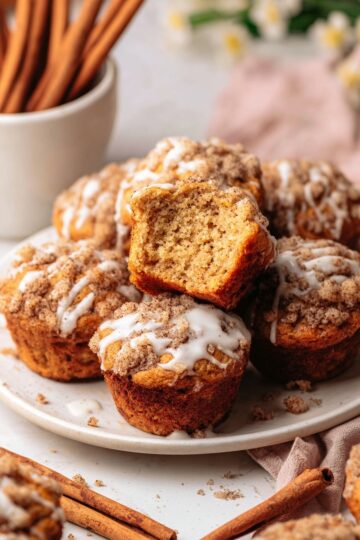

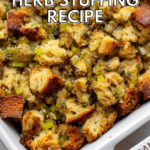
Leave a Reply